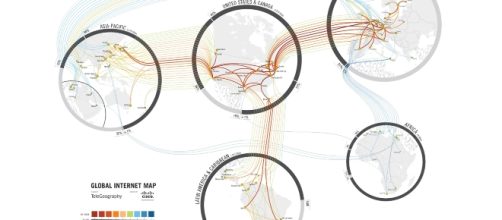Facebook wants to put a fleet of light aircraft in Angels 60 (60,000 ft. or 18,300 m.) orbits over unserved regions of the planet to provide internet access. But, how practical is this idea from a technical standpoint, let alone geopolitical, or financial?
Technological barriers
The Facebook flying internet system involves fleets of their aircraft, each weighing one thousand pounds or so with the wingspan of a jumbo jet flying day and night on only 5Kw of power. One slight problem is that the craft which are intended to stay aloft for 90 days have never been tested.
So far, one model flew for just over an hour and a half.
Then there is the ground side of this project. How much would it cost to build solar panel arrays, and antennas in the middle of nowhere? Without that infrastructure, it hardly matters how many Aquilas are launched. Also, how do you inform a billion people with ten thousand languages and give them technical skills to build the ground stations for a home or village?
I was unable to find any technical specs either for the power of the plane’s transmitter or what sort of ground system is required to access the two-way Internet service. Much of the world can already access satellite TV but billions of people do not, are those same people would be technically or financially capable of or even interested in such a project?
From a technical standpoint, I didn’t find the Facebook pages about this concept to be very reassuring. One page cites 4 billion people as the unserved target audience while another official page uses the number 1.6 billion. But how about the basics of flight? The “technical” page describing the product shows a $200,000 (my estimate) crane loading the craft onto its launching cradle and elsewhere points out that airliners fly at “more” that 200 mph. True, but slightly off-putting in a technical document when you realize that a 747 actually flies at upwards of 570 mph.
Another technical point I find worrying is that while each Aquila is supposed to provide Internet access to a 60-mile diameter area, the descriptions only include the power requirement for flight power, with no mention of how much power the transmitter(s) would require.
Satellites in the Clark Belt (26,200 mile high orbit) have no problem transmitting signals to the surface as they require no continuing power to stay aloft because they are in orbit, and are also in continuous sunlight and hence need little in the way of battery backup compared to a system which has to both stay aloft and continue transmitting during up to 14 hours of darkness.
Geopolitics
Some of the places underserved by the world wide web include North Korea, China, and Russia where the problem isn’t technology but censorship. One can only imagine what would happen to Aquilas flying in those country’s airspace, as big as a 747 and slower than many birds.
In addition, although the aircraft themselves are entirely automated, a sizeable crew of technicians and a runway must be provided to support each flotilla.
These are, of course, subject to various environmental and social problems since they are necessarily in remote, extremely poor, and often politically unstable areas.
Financial Challenges
Internet companies such as Facebook have loads of money, but Lotus (the first big spreadsheet software company located near my garage in Cambridge, MA.) had a lot of money and most people have never heard of it today. Anyone remember The Source, a GE company, one of the first Internet companies which hosted various news services? Or, how about Radio Shack? People forget they were the largest computer retailer in the world and that their Color Computer was far superior to the early Mac. So, given the rapid changes in information technology which the Internet in large part has been responsible for, will Facebook even be in business long enough to build and launch all the proposed aircraft transceivers, let alone continue keeping them maintained and airborne for several decades?

